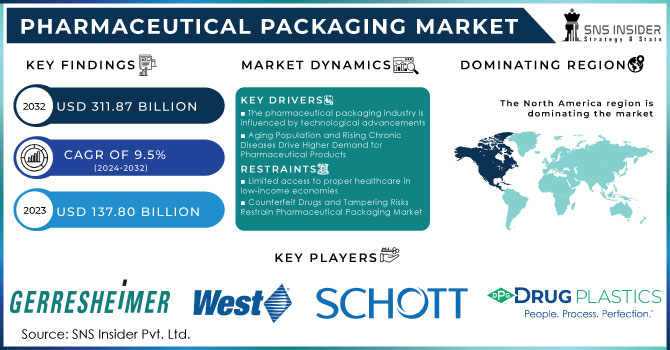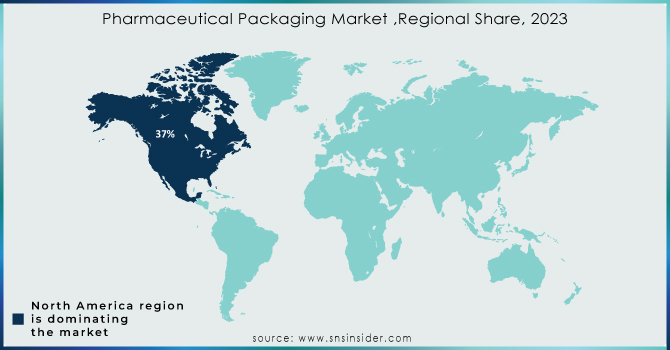Pharmaceutical Packaging Market Key Insights:

Get PDF Sample Copy of Pharmaceutical Packaging Market - Request Sample Report
The Pharmaceutical Packaging Market size was valued at USD 137.80 billion in 2023 and is expected to Reach USD 311.87 billion by 2032 and grow at a CAGR of 9.5% over the forecast period of 2024-2032.
One of the main factors driving the pharmaceutical packaging market's growth is the enormous expansion of the pharmaceutical industry. Scientific and technological advancements have caused the pharmaceutical industry to grow quickly in recent years, and it is expected that this trend will continue over the projection period, particularly in developing countries like China, India, and Brazil. The largest pharmaceutical market worldwide was in the US.
The advancement of medicine and bioscience is what primarily drives the pharmaceutical industry. The pharmaceutical industry is undergoing a significant transformation, and over the past few years, the emphasis on developing biopharmaceutical drugs has significantly increased. Few biotechnology-based drug therapies are introduced as lyophilized or dry powder dosage forms because they are unstable in liquid form. Lyophilized medications require Sustainable Pharmaceutical Packaging for their best performance, creating new business opportunities for packaging suppliers.
Pharmaceutical medications are primarily sold as tablets, capsules, liquids, and powders. They are packaged in a variety of packaging formats, such as rigid bottles, standup pouches, flat pouches, sachets, and Blister Packaging. The incorporation of dispensing mechanisms, administration aids, sustainable materials, tamper-evident characteristics, and anti-counterfeiting measures into packaging is a growing area of focus for packaging companies.
To increase the use of green packaging, businesses are primarily focusing on the use of post-consumer recycled (PCR) material and developing packaging from compostable material.
MARKET DYNAMICS
KEY DRIVERS:
-
The pharmaceutical packaging industry is influenced by technological advancements
Serialization, track-and-trace methods, and active & intelligent packaging techniques are all examples of printing technology. These technological advancements help to increase safety, efficiency, supply chain visibility, and patient engagement, which helps to advance the market.
-
Pharmaceutical products are in higher demand as a result of the aging population, the growing number of chronic diseases, and the expanding global population.
RESTRAIN:
-
Limited access to proper healthcare in low-income economies
Due to financial limitations, access to quality healthcare is frequently restricted in low-income or underserved populations. This may lead to a decreased ability to afford pharmaceutical products, affecting both the demand for packaging solutions and the overall demand for medications.
-
The pharmaceutical industry faces significant risks related to counterfeit drugs and tampering. This is a restraining factor for the pharmaceutical packaging market.
OPPORTUNITY:
-
Growing Demand for Patient-Centric Packaging
Patient-centric packaging strategies that improve medication adherence, usability, and patient safety are receiving more attention. There are opportunities for packaging designs that include elements like user-friendly dosing mechanisms, clear instructions, and enhanced accessibility for patients with special needs or disabilities.
-
Large growth potential exists in the pharmaceutical packaging market in emerging markets, particularly in Asia, Latin America, and Africa.
CHALLENGES:
-
Counterfeit drugs and tampering pose serious challenges to the pharmaceutical packaging market
Patient safety and brand reputation are seriously threatened by counterfeit drugs and tampering. The pharmaceutical packaging industry is constantly challenged with creating and putting into practice efficient anti-counterfeiting measures, such as track-and-trace technologies, holograms, and authentication systems, to stop illegal activities and protect the supply chain.
IMPACT OF RUSSIA-UKRAINE WAR
Aesthetic product operations have been suspended, and new clinical trials in Russia have been put on hold, by the American biopharma company AbbVie. Many companies, including Pfizer, Bayer, Sanofi, and others, have postponed new investments or construction in the nation.
However, in accordance with international humanitarian law, pharmaceutical companies like Abbott Laboratories and Johnson and Johnson have maintained operations in Russia and provided access to medications and medical supplies.
US, UK, Europe and Canada have disconnected seven Russian banks from the SWIFT global payment system, refusing to pay for medicines and medical supplies. This had an effect on the export of medical equipment from the EU to Russia.
The ongoing war has also hampered trade with India, one of Russia's major suppliers of generic medications. Pharmaceutical companies in a number of Indian states claimed they hadn't been paid for medicines exported to Russia.
Shipments to the Commonwealth of Independent States, Russia, and Ukraine are backed up at Indian ports. Production cycles have been hampered by payment delays, which have left manufacturers with little cash to cover daily expenses.
The rising cost of aluminum foil, which is frequently used in drug packaging, has added pressure to the already constrained supply. The export of foil is frequently notable.
IMPACT OF ONGOING RECESSION
Because of the diversity of the biopharmaceutical market, it is difficult to make generalizations about how a recession might affect it. Therefore, it's crucial to distinguish between the possible effects of the recession on various industry players. For instance, the generics industry would probably be affected differently than the research-based drug industry.
The compound annual growth rate of R&D spending in the pharmaceutical industry will abruptly decline during a recession. The industry will also invest significantly less in R&D.
KEY MARKET SEGMENTATION
By Raw Material
-
Plastics
-
Polymers
-
Aluminium Foil
-
Others
By Product Type
-
Primary
-
Secondary
By End Use
-
Pharma Manufacturing
-
Retail Pharmacy
-
Institutional Pharmacy
REGIONAL ANALYSIS
In 2023, the North American region dominated the pharmaceutical packaging market with a total market revenue share of 37%. The presence of many pharmaceutical packaging manufacturers in the region has given growth in the region.
During the forecast period, Asia Pacific is anticipated to experience the fastest CAGR of more than 10%. Over the forecast period, it is anticipated that rising disposable income levels and rising health awareness among consumers in the Asia Pacific, particularly in developing nations like China and India, will support the growth of the pharmaceutical industry and increase demand for its packaging. Due to expanding government initiatives, rising contract manufacturing activities, and a rapidly aging population, China is dominating the Asia Pacific regional market.
Due to increased R&D efforts and the introduction of new medications aimed at enhancing patient health and quality of life, Europe is predicted to experience significant growth.

Get Customized Report as per Your Business Requirement - Enquiry Now
REGIONAL COVERAGE
North America
-
USA
-
Canada
-
Mexico
Europe
-
Germany
-
UK
-
France
-
Italy
-
Spain
-
The Netherlands
-
Rest of Europe
Asia-Pacific
-
Japan
-
South Korea
-
China
-
India
-
Australia
-
Rest of Asia-Pacific
The Middle East & Africa
-
Israel
-
UAE
-
South Africa
-
Rest of the Middle East & Africa
Latin America
-
Brazil
-
Argentina
-
Rest of Latin American
Key Players
Some major key players in the Pharmaceutical packaging market are West Pharmaceutical Services Inc, Gerresheimer AG, International Paper, Vetter Pharma International, Schott AG, Drug Plastics Group, CCL Industries Inc, SGD Pharma, Becton, Dickinson, and Company, WestRock Company, and other players.
RECENT DEVELOPMENTS
-
SGD Pharma, A joint venture between glass pharmaceutical packaging company SGD Pharma and materials science pioneer Corning has announced to establish a glass tubing facility in India.
-
Bormioli Pharma, A number of partnerships between companies have been announced by Bormioli Pharma with the goal of enhancing the functionality and sustainability of glass used in pharmaceutical applications.
| Report Attributes | Details |
| Market Size in 2023 | US$ 137.80 Bn |
| Market Size by 2032 | US$ 311.87 Bn |
| CAGR | CAGR of 9.5% From 2024 to 2032 |
| Base Year | 2023 |
| Forecast Period | 2024-2032 |
| Historical Data | 2020-2022 |
| Report Scope & Coverage | Market Size, Segments Analysis, Competitive Landscape, Regional Analysis, DROC & SWOT Analysis, Forecast Outlook |
| Key Segments | • by Raw Material (Plastics, Polymers, Paper & Paperboard, Aluminium Foil, Others) • by Product Type (Primary, Secondary) • by End Use (Pharma Manufacturing, Retail Pharmacy, Institutional Pharmacy, Contract Packaging) |
| Regional Analysis/Coverage | North America (USA, Canada, Mexico), Europe (Germany, UK, France, Italy, Spain, Netherlands, Rest of Europe), Asia-Pacific (Japan, South Korea, China, India, Australia, Rest of Asia-Pacific), The Middle East & Africa (Israel, UAE, South Africa, Rest of Middle East & Africa), Latin America (Brazil, Argentina, Rest of Latin America) |
| Company Profiles | West Pharmaceutical Services Inc, Gerresheimer AG, International Paper, Vetter Pharma International, Schott AG, Drug Plastics Group, CCL Industries Inc, SGD Pharma, Becton, Dickinson, and Company, WestRock Company |
| Key Drivers | • The pharmaceutical packaging industry is influenced by technological advancements • Pharmaceutical products are in higher demand as a result of the aging population, the growing number of chronic diseases, and the expanding global population. |
| Market Opportunities | • Growing Demand for Patient-Centric Packaging • Large growth potential exists in the pharmaceutical packaging market in emerging markets, particularly in Asia, Latin America, and Africa. |

